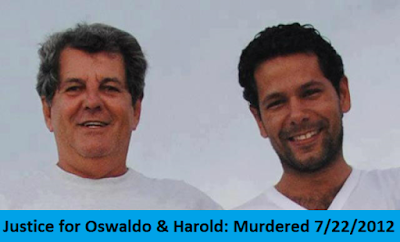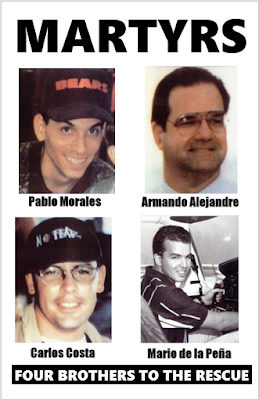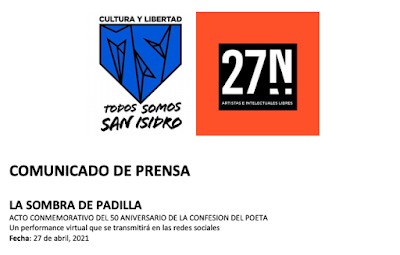"Long live human rights, with my blood I wrote to you so
that this be saved as evidence of the savagery we are subjected to that are victims of the Pedro Luis Boitel political prisoners [movement]" - Orlando Zapata Tamayo, letter smuggled out April of 2004*
Cuban Prisoner of Conscience Orlando Zapata Tamayo
Tortured and Murdered by Cuban Government Officials
Fact #1 Orlando Zapata Tamayo was murdered by Cuban government officials
Both Abel Lopez Perez and Reina Luisa Tamayo charge that Cuban prison
officials denied Orlando Zapata Tamayo water in an effort to break his
spirit. Reina Luisa Tamayo in an interview with Yoani Sanchez, hours
after her son’s death denounced that officials had denied him water.[1]
Abel Lopez corroborates the charge stating: “Before Zapata was checked
into the hospital, he was regularly taking some vitamins. He was in a
weak state of health. A military chief known as ‘Gordo’, who was the one
responsible for ordering all of Zapata’s things to be taken out of the
cell and to stop giving him water, also took his bottle of vitamins and
poured all the pills down a drain. He told him, ‘Those who are in
protest here don’t drink vitamins. I think those are pills sent to you
by the Yankees so you can continue your hunger strike.’ Those were the
exact words said to him, I verified them. His vitamins were taken away,
as were any other medications. And they stopped giving him water for a
while.”[2] This type of practice was also documented in the 1966 death
of another Cuban hunger striker, Roberto López Chávez.[3], [4] Denying
water to a man on water only hunger strike is cruel and inhuman
treatment that contributed to his death.
Fact #2 Orlando Zapata Tamayo was an Amnesty International prisoner of conscience
Orlando Zapata Tamayo was recognized as an Amnesty International (AI)
prisoner of conscience on January 29, 2004 a designation given only to
nonviolent activists after careful examination.[5] On January 29, 2004
Amnesty International outlined Orlando Zapata Tamayo’s past arrests:
“He has been arrested several times in the past. For example he was
temporarily detained on 3 July 2002 and 28 October 2002. In November
2002 after taking part in a workshop on human rights in the central
Havana park, José Martí, he and eight other government opponents were
reportedly arrested and later released. He was also arrested on 6
December 2002 along with Oscar Elías Biscet[6], but was released on 8
March 2003. Most recently, he was arrested on the morning of 20 March
2003 whilst taking part in a hunger strike at the Fundación Jesús Yánez
Pelletier, Jesús Yánez Pelletier Foundation, in Havana, to demand the
release of Oscar Biscet and other political prisoners.”[7]
Orlando Zapata Tamayo appeared photographed in the Cuban government’s
own publication Los Disidentes, in photos prior to his 2003 arrest and
was then recognized by Cuban officials as a dissident. The Spanish
newspaper El Mundo carried a photo the day after the Cuban regime
announced the death of Orlando Zapata Tamayo with prominent Cuban
dissidents.[8]
Fact #3 Orlando Zapata Tamayo’s hunger strike was an act of non-violent self-defense
Orlando Zapata Tamayo had been beaten and tortured on more than one
occasion by prison guards and state security along with other prisoners.
His body was scarred and his health in decline. For example Amnesty
International reported that, on "October 20, 2003 [Orlando Zapata] was
dragged along the floor of Combinado del Este Prison by prison officials
after requesting medical attention, leaving his back full of
lacerations."[9] Cuban political prisoner Abel Lopez Perez transferred
to the same prison in Camaguey as Orlando Zapata Tamayo on December 3,
2009 briefly saw him and heard from other prisoners “that a few days
before being taken away, Zapata stood up and shouted, ‘People, don’t let
yourselves be lied to. Don’t believe anything that they tell you. I’m
not demanding a kitchen or any of the things they took away from me. I’m
demanding an improvement of treatment for all prisoners, and so you all
know, I am going to die for it.’”[10] The case of Ariel Sigler Amaya,
another Cuban prisoner of conscience, is instructive. He had to threaten
a hunger strike, although already emaciated and crippled, to obtain
medical treatment to save his life.[11] The hunger strike was not an act
of suicide but rather a tactic of self defense within the arsenal of
nonviolent options.
Fact #4 Between 1966 and 2010 at least six Cuban political prisoners
died while on hunger strike: Roberto López Chávez , Carmelo Cuadra
Hernández , Pedro Luis Boitel, Olegario Charlot Pileta, Enrique García
Cuevas and Orlando Zapata Tamayo.
Roberto López Chávez, 25 years old, died on December 11, 1966 in Isla de
Pinos prison on hunger strike without medical assistance.[12] Armando
Valladares, in his prison memoir, Against All Hope described the
circumstances surrounding his death: “When Roberto López Chávez, went on
a hunger strike to protest the abuses in the prison, the guards
withheld water from him until he became delirious, twisting on the floor
and begging for something to drink. The guards then urinated in his
mouth. He died the next day.”[13], [14]
Carmelo Cuadra Hernández, died in La Cabaña prison in April of 1969 on
hunger strike, after suffering mistreatment and torture over eight and a
half months, without receiving medical care and was the third political
prisoner that has died on a hunger strike.[15], [16]
Pedro Luis Boitel died on hunger strike on May 25, 1972.[17],[18]
Olegario Charlot Pileta, died in the famous "Escaleras" (staircase) of
the Boniato prison, in of January 1973 during a hunger strike, without
medical assistance and is described in documents as a “black youth.”
[19],[20]
Enrique García Cuevas died on a hunger strike, without receiving medical
care, in cell No. 4 of the new Provincial Jail of Santa Clara, on June
24, 1973.[21]
Two of the four outlined above died on hunger strikes after Pedro Luis
Boitel and there are partial estimates that place the number identified
to have died while on hunger strike at twelve including both Boitel and
Zapata. Since the death of Pedro Luis Boitel there are partial lists
identifying six political prisoners dead on hunger strikes between May
25, 1972 and February 23, 2010.[22]
Sources:
1. Sanchez, Yoani “Orlando Zapata Tamayo's Mother Speaks After Her Son's Death” The Huffington Post February 24, 2010
http://www.huffingtonpost.com/yoani-sanchez/orlando-zapata-tamayos-mo_b_475006.html
2. Felipe Rojas, Luis “Abel Remembers the Last Days of Zapata in a
Prison of Camaguey” Crossing the Barbed Wire November 24, 2010
http://cruzarlasalambradaseng.wordpress.com/2010/11/24/abel-remembers-the-last-days-of-zapata-in-a-prison-of-camaguey/
3. Valladares, Armando Against All Hope: The Prison Memoirs of
Armando Valladares (1st edition Knopf April 12, 1986) quote taken from
(1st Edition Encounter Books April 1, 2001) pg. 379
4. Glazov, Jamie United in Hate: The Left's Romance with Tyranny and Terror WND Books, 2009 Pg 48
5. Amnesty International “CUBA Newly declared prisoners of conscience” January 29, 2004
https://www.amnesty.org/en/documents/AMR25/002/2004/en/
6. Quintero, Tania “CUBA | Llorando a un amigo ¡Así te voy a recordar, Orlando!” El Mundo February 24, 2010
http://www.elmundo.es/america/2010/02/24/cuba/1267020583.html
7. Amnesty International “CUBA Newly declared prisoners of conscience” January 29, 2004
https://www.amnesty.org/en/documents/AMR25/002/2004/en/
8. Felipe Rojas, Luis “Abel Remembers the Last Days of Zapata in a
Prison of Camaguey” Crossing the Barbed Wire November 24, 2010
http://cruzarlasalambradaseng.wordpress.com/2010/11/24/abel-remembers-the-last-days-of-zapata-in-a-prison-of-camaguey/
9. Rodriguez, Eliott “Paralyzed Former Cuban Prisoner Arrives In Miami” CBS4 July 28, 2010
http://cbs4.com/local/ariel.amaya.cuban.2.1829264.html
10. Inter-American Commission on Human Rights “Annual Report 1975: 1805 Cuba”
http://www.cidh.org/annualrep/75eng/Cuba1805.htm
11. Valladares, Armando Against All Hope: The Prison Memoirs of
Armando Valladares (1st edition Knopf April 12, 1986) quote taken from
(1st Edition Encounter Books April 1, 2001) pg. 379
12. Glazov, Jamie United in Hate: The Left's Romance with Tyranny and Terror WND Books, 2009 Pg 48
13. Inter-American Commission on Human Rights SITUATION OF POLITICAL PRISONERS IN CUBA (1976)
http://www.cidh.org/countryrep/cuba76eng/chap.1.htm
14. Inter-American Commission on Human Rights SEGUNDO INFORME SOBRE
LA SITUACIÓN DE LOS PRESOS POLÍTICOS Y SUS FAMILIAS EN CUBA May 7, 1970
http://www.cidh.org/countryrep/Cuba70sp/cap.1b.htm
15. Amnesty International “CUBA Newly declared prisoners of conscience” January 29, 2004
https://www.amnesty.org/en/documents/AMR25/002/2004/en/
16. Inter-American Commission on Human Rights “
Annual Report 1975: 1805 Cuba”
http://www.cidh.org/annualrep/75eng/Cuba1805.htm
17. Tamayo, Juan O. “Jailed Cuban activist Orlando Zapata Tamayo dies on hunger strike” The Miami Herald February 23, 2010
http://www.miamiherald.com/2010/02/23/1496572/cuban-activist-dies-on-hunger.html
18. Inter-American Commission on Human Rights 6TH REPORT ON THE
SITUATION OF POLITICAL PRISONERS IN CUBA: CHAPTER III: AN ANALYSIS OF
CERTAIN INDIVIDUAL CASES SUBMITTED TO THE IACHR 14 December 1979
http://www.cidh.org/countryrep/cuba79eng/chap.3.htm
19. Inter-American Commission on Human Rights CHAPTER I SITUATION OF POLITICAL PRISONERS IN CUBA (1976)
http://www.cidh.org/countryrep/cuba76eng/chap.1.htm
20. Inter-American Commission on Human Rights “Annual Report 1975: 1805 Cuba”
http://www.cidh.org/annualrep/75eng/Cuba1805.htm
21. Inter-American Commission on Human Rights CHAPTER I SITUATION OF POLITICAL PRISONERS IN CUBA (1976)
http://www.cidh.org/countryrep/cuba76eng/chap.1.htm
22. Corzo, Pedro “El calvario de las prisiones cubanas” El Nuevo Herald March 13, 2010
http://www.elnuevoherald.com/2010/03/13/674331_p2/pedro-corzo-el-calvario-de-las.html






















